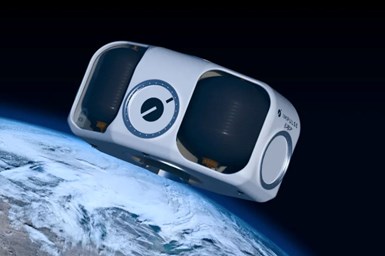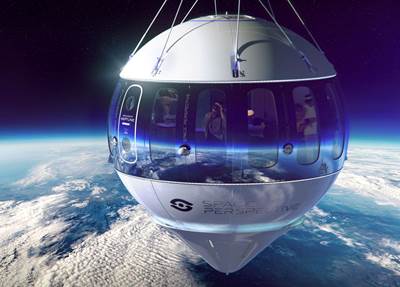Impulse Space to launch first orbital service vehicle in 2023 using CFRP tanks
Interview with COO discusses carbon fiber composites in tanks, vehicles and their role in space commerce as part of rapidly growing New Space economy.
Rendering of Impulse Space multi-service vehicle to provide economical and flexible last-mile delivery of payloads in space. Photo Credit: Impulse Space
Impulse Space Inc. (El Segundo, Calif., U.S.), a company providing in-space transportation services for the inner solar system, has announced its first orbital mission, LEO Express-1, utilizing its first orbital service vehicle, Mira. This mission will perform in-space services, including last-mile orbital payload delivery, payload hosting, very low altitude maneuvers and controlled atmospheric re-entry.
LEO Express-1 has confirmed space on SpaceX’s Transporter-9 mission powered by its SpaceX Falcon 9 rocket, and Impulse Space is committed to meeting the current launch timeline of Q4 2023. Impulse says it will be among the first companies to demonstrate rapid in-space transportation services through high-thrust chemical propulsion.
“Our team is thrilled to announce LEO Express-1 as our first mission and the implications it brings to affordable space access,” says Impulse Space Founder and CEO Tom Mueller. “Currently, smallsat operators with custom orbit requirements need to pay a premium or compromise their spacecraft designs to include additional on-board propulsion capability. Impulse’s LEO Express missions will provide the industry with a reliable, rapid and consistent service for precisely delivering payloads to custom orbits in low Earth orbit [LEO].”
The primary payload of LEO Express-1 is currently undisclosed, but additional payload space is available for secondary customers to join the mission. For more information on Impulse Space, additional missions and payload availability, contact sales@impulsespace.com.
Q&A with Impulse Space COO
CW Senior Technical Editor, Ginger Gardiner, spoke with Impulse Space COO, Barry Matsumori, about the company’s planned vehicles and potential use of carbon fiber-reinforced composites.
CW: Aviation Week referred to your vehicles as “space tugs.” What are these and why build them?
Matsumori: Space tug implies a very limited or singular function of transporting an object from point A to point B in space. We prefer orbital service vehicle because it’s a broader target including but not limited to transport. If we already have a vehicle that's moving through space, then it can provide multiple services while it’s there.
CW: Why are such vehicles going to be needed?
Matsumori: I would suggest the need is already there. For example, satellites need assistance if their orbit declines due to a malfunction in the propulsion system, or some other anomaly. The need for a vehicle that can go and restore that satellite to a functional orbit already exists. Beyond that, there are services that can really expand what can be done in space. For example, the traditional notion is that a satellite is placed in an orbit and stays in that orbit. But if a satellite can actually move its orbit to provide the best kind of coverage for its sensors or communications over a given area, then all of a sudden, the utility of that asset increases.
And once our vehicle has provided that service it can then provide other functions while it waits to provide its next service assignment. For example, it can assist with space situational awareness (SSA), which means observing what’s happening in the space orbits, particularly concerning orbital debris, to prevent a conjunction event — i.e., when an object can hit another object in space. SSA typically is done from Earth with a myriad of telescopes and radar to monitor the objects in space, but the type of multifunctional vehicles we are launching can augment that data.
CW: These vehicles must be launched as a payload?
Altitudes of various Earth orbits. Photo Credit: Ahmed Maher; “5G and Satellite Network Convergence: Survey for Opportunities, Challenges and Enabler Technologies” by Mohamed Adel Elbahaay, et. al, 2020.
Matsumori: They are launched like you would launch a satellite. But that is an interesting aspect that is changing because of the volume of business that’s happening in space, and it adds to the need for our vehicles. Until now, the model has been that you go from Earth with a rocket and deliver a payload, usually a satellite, into a given orbit. And in the case of SpaceX, they’re able to reuse the first stage, but the second stage is thrown away. However, to lower the cost per kilogram you need to reuse the first and second stages, and the way to do that is to have the second stage stop at LEO, because the higher it goes, the more challenging it is to bring it back to Earth. From the LEO altitude, transport vehicles can pick up payloads and distribute them to the desired final orbit which could be higher within LEO, a medium Earth orbit (MEO), geostationary Earth orbit (GEO) or even to the moon or Mars.
CW: What are the sizes and design drivers for these vehicles, and will they use composites?
Matsumori: The final destination or orbit will dictate the vehicle size. If one is doing a lower orbit transfer, then a small vehicle will suffice, but if you’re going from LEO to a geostationary orbit of some sort, then you need a larger vehicle. Obviously, if you’re going to the moon or Mars, the vehicle will need to be much larger. Thus, a family of vehicles is needed.
Impulse Space’s eventual family of vehicles will span small, medium and large sizes. Its first launch in 2023 will be a small vehicle, one of many payloads in the SpaceX Transporter-9 mission, with two pressure vessels using CFRP that could measure roughly 0.5 meter long × 0.33 meter in diameter. Photo Credit: Impulse Space
The vehicle shapes and mass fraction — the ratio between how much the spacecraft weighs versus how much propellant it carries — will be designed to meet these varying mission needs. Composites definitely help achieve a more optimized mass fraction. If you use metals, the vehicle tends to get heavier. We pay the launch provider for every kilogram of mass that is launched, so we are incentivized to reduce weight.
All satellites and payload designs are driven by the loads during launch and by having to fit inside the payload fairing of the launch system. Our goal for the small vehicle is to be able to transport a 300-kilogram payload to any of the orbits within LEO. On the other end of the spectrum, a very large vehicle should be able to transport 5,000 kilograms to a geostationary orbit. And that size of vehicle would be large enough to occupy all of a Falcon 9 launcher.
CW: The very large vehicle would be a single payload for the Falcon 9?
Matsumori: It would be a single vehicle with the payload on top and would fill the Falcon 9 fairing. Just to give you an example.
CW: Then how would your smaller vehicle be sized?
Matsumori: Well, we’ll be on the ninth SpaceX Transporter mission, where SpaceX bundles a number of missions together into one launch. This transporter launcher holds the various payloads in a column inside the payload fairing and releases them at the appropriate orbit. There could be as many as 20 payloads inside.
CW: The current rendering of an Impulse Space service vehicle appears to use two carbon fiber-reinforced composite tanks. Can you discuss these tanks?
Matsumori: Yes, we could use Type V linerless or Type III aluminum tanks overwrapped with CFRP [carbon fiber-reinforced polymer], depending on what the requirements are for each vehicle. Linerless is everyone’s goal because it helps to optimize mass fraction by eliminating the weight of the liner. We have a 4-meter-long filament winder and will produce these tanks in-house. For the small vehicles, the tank size will start at roughly 0.5 meter long and 0.33 meter in diameter. We will scale up the tank size as we proceed with the medium and larger vehicles.
CW: And what cryogenic fuel will these contain?
Matsumori: Actually, in order for these vehicles to provide service on call or be able to idle between scheduled service missions, we need storable propellants that aren’t cryogenic. We cannot keep cryogenic liquids cold long enough for the storage times we require, at least not with current technology. Instead, we will use nitrous oxide as the oxidizer — which is not only affordable and storable but non-toxic — and ethane, a chemical variant of propane, will be the other propellant. Our tanks will be pressure vessels that store these at the same pressures as you would see on Earth. And these propellants may be stored as gas or as liquid that is then heated and combusted as a gas, but they are not cryogens.
CW: What kind of production rate do you project? How many vehicles and tanks will you be making per year?
Matsumori: We could certainly see something like 20 small vehicles, 10 medium vehicles and probably another 10 of the largest vehicles annually in 10 years. [Each vehicle will use two tanks — one for the oxidizer and one for the fuel.] Our plan is to reuse the vehicles, but we don’t yet know how many cycles that will be. When I was at SpaceX, we thought getting 10 reuse cycles out of a first stage was going to be really good, but now they’ve managed to get more than 15 reuse cycles. For us, we will have to reuse a propulsion system several times and that’s pretty new territory. We just don’t know how many cycles we can get out of them yet. As space commerce increases, we will increase the number of our vehicles in use, so there will be older and newer vehicles and we will replace the older vehicles as they wear out.
CW: Beyond tanks, do you anticipate using composites in the load-bearing structure of these vehicles?
Matsumori: Composites will be used where it makes sense. For example, using metal solar array frames is pretty heavy, so that is a good application for composites, and also certain fittings and main structures, as long as they are cost-competitive with metals. It depends on the application and complexity of the structure. And composites are now competing with metal additive manufacturing, because it offers the only way to really optimize the shapes of these structures. That same complexity certainly can be done with composites, but if you have really fine details, the metal additive manufacturing will be the best option.
This raises a really important point: We must provide the low cost and high reliability required for these vehicles. For example, the propulsion system that I just mentioned — using ethane and nitrous oxide — that’s been done before. So, we are trying to have the least complex, yet most efficient system. And just like SpaceX, in order to have the market grow, we must provide a low-cost service. Quite a few of us at Impulse Space are from SpaceX, and that is the paradigm we’re following. And that growth then enables volumes that help companies like ours to realize economies of scale. Thus, our strategy is low-cost, reliable designs with vehicle production volumes that enable elasticity and growth in the market.
CW: Your production volume will not be that of a narrowbody commercial airliner, for example, but it will be much higher than the historical volumes of space vehicles produced?
Matsumori: Absolutely. This isn’t a volume that the space industry has seen before. Can we grow to thousands of vehicles? Sure. I just don’t know right now what the market will do. For example, vehicles like the SpaceX Starship will revolutionize space for one reason alone — the cost per kilogram to launch will drop so low that it allows things like production of materials in space to be feasible. So, doing manufacturing and assembly in space becomes feasible. It just changes how space can be treated, not only to service Earth, but to service space commerce for the sake of itself.
About Impulse Space
Founded in 2021, Impulse Space is a Space 2.0 pioneer providing agile, economical space logistics services. With a near-term focus on LEO, services include in-space transportation to custom orbits, in-space payload hosting and precision re-entry trajectory injection. Long-term, Impulse will offer delivery services for all classes of payloads to distant destinations such as GEO, the moon and Mars.
Related Content
A new era for ceramic matrix composites
CMC is expanding, with new fiber production in Europe, faster processes and higher temperature materials enabling applications for industry, hypersonics and New Space.
Read MorePlant tour: Spirit AeroSystems, Belfast, Northern Ireland, U.K.
Purpose-built facility employs resin transfer infusion (RTI) and assembly technology to manufacture today’s composite A220 wings, and prepares for future new programs and production ramp-ups.
Read MoreMaterials & Processes: Fabrication methods
There are numerous methods for fabricating composite components. Selection of a method for a particular part, therefore, will depend on the materials, the part design and end-use or application. Here's a guide to selection.
Read MoreCarbon fiber in pressure vessels for hydrogen
The emerging H2 economy drives tank development for aircraft, ships and gas transport.
Read MoreRead Next
High glass transition temperature, 100% bio-based thermoset resins for space composites
With the European Commission Restrictions Roadmap soon banning entire classes of chemical substances found in fossil fuel-based synthetic polymers, the space industry is looking to a chemical combination to produce competitive thermoset resins.
Read MoreVirtek Iris 3D system enables sustainable space tourism experience
Vision positioning system accelerates composite layup processes and reduces labor-intensive tasks for production of Space Perspective’s pressurized capsule.
Read MoreFrom the CW Archives: The tale of the thermoplastic cryotank
In 2006, guest columnist Bob Hartunian related the story of his efforts two decades prior, while at McDonnell Douglas, to develop a thermoplastic composite crytank for hydrogen storage. He learned a lot of lessons.
Read More

































